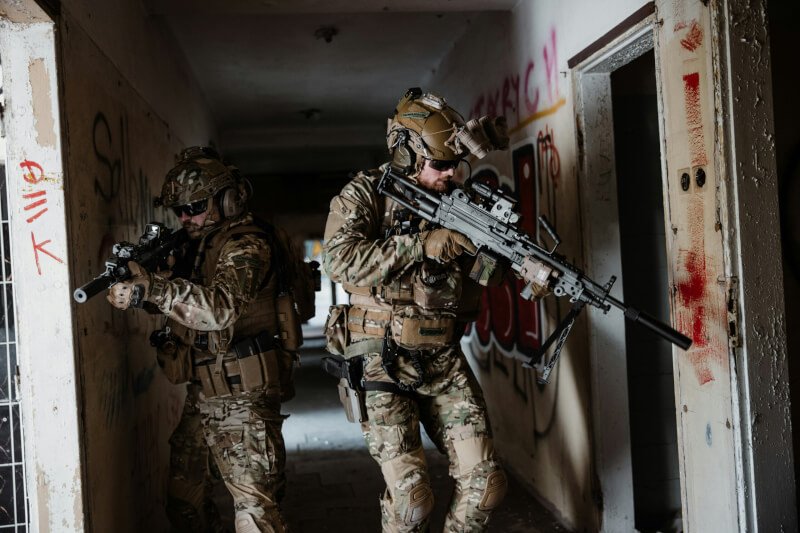Are you ready to take your airsoft game to the next level? Look no further than this comprehensive guide to mastering tactical ambushes and lures in the world of airsoft. Whether you’re a seasoned player or new to the sport, this article will provide you with the skills and strategies you need to outsmart your opponents and come out on top. From setting up the perfect ambush location to luring your opponents into a trap, we’ve got you covered. Get ready to dominate the field with our in-depth guide to airsoft tactical ambushes and lures.
Understanding Airsoft Tactical Ambushes
Airsoft is a thrilling and competitive team-based sport that requires strategic planning and execution. One of the most effective tactics in Airsoft is the ambush, where a team strategically positions themselves to surprise and overpower their opponents. In this comprehensive guide, we will take a closer look at the art of airsoft tactical ambushes – from planning and preparation to execution and dealing with counter-ambush strategies.

1. Ambush Planning and Preparation
Gathering Intelligence
Before launching an ambush, it is crucial to gather intelligence about your opponents. This can be done through observation during gameplay or by analyzing their tactics in previous encounters. Knowing your opponents’ strengths, weaknesses, and preferred strategies will allow you to tailor your ambush plan accordingly.
Identifying Suitable Ambush Locations
The success of an ambush heavily depends on choosing the right location. Ideal ambush locations offer good cover, concealment, and strategic advantages. Look for areas with limited visibility, dense foliage, and natural obstacles that provide an advantage to your team. By carefully studying the terrain and scouting potential ambush spots, you can maximize the element of surprise.
Establishing Ambush Objectives
Clearly defining your ambush objectives is essential for a successful operation. Determine what you aim to achieve through the ambush – whether it is eliminating high-value targets, capturing an objective, or causing confusion among the enemy ranks. By having specific goals in mind, you can effectively allocate resources and plan your ambush accordingly.
Formulating an Ambush Plan
Once you have gathered intelligence, identified suitable locations, and established objectives, it is time to formulate a detailed ambush plan. This plan should outline the overall strategy, team positions, target identification, and contingencies. Consider factors such as timing, coordination, and communication channels to ensure a synchronized and effective ambush.
2. Building an Effective Ambush Team
Selecting Team Members
Building a cohesive and skilled ambush team is crucial for success. Consider each team member’s strengths, skills, and experience when selecting them for the operation. A well-rounded team may include members with expertise in reconnaissance, marksmanship, stealth, and communication.
Assigning Roles and Responsibilities
Once the team is assembled, assign specific roles and responsibilities to each member. Designate a team leader, rear security, point man, and individuals responsible for communications, firepower, and medical aid. By clearly defining roles, everyone will have a clear understanding of their duties during the ambush.
Training and Rehearsing Ambush Drills
To build a seamless and effective ambush team, regular training and rehearsals are necessary. Conduct drills that simulate various ambush scenarios and practice communication, coordination, and target acquisition. By repeatedly practicing these drills, team members will develop a strong sense of teamwork and improve their overall performance during actual ambush operations.
3. Concealment and Camouflage Techniques
Choosing the Right Camouflage Gear
Proper camouflage gear is essential for blending into the environment and remaining undetected. Select gear that matches the color and pattern of the terrain you will be operating in. Additionally, consider wearing gear that minimizes noise and restricts movement, enhancing your ability to remain hidden.
Utilizing Natural Elements for Concealment
In addition to camouflage gear, take advantage of the natural elements present in the environment for enhanced concealment. Utilize bushes, rocks, trees, and other features to break up your silhouette and blend into your surroundings. By carefully positioning yourself in areas of dense vegetation, you can maintain a hidden position while maintaining observation of your targets.
Applying Camouflage Techniques to Blend In
Camouflage is not limited to gear and natural elements – it also involves the skillful use of movement, light, and shadows to create deception. Move slowly and silently, being mindful of any potential noise that could give away your position. Additionally, use the available terrain to your advantage by positioning yourself in areas that cast shadows, making it difficult for opponents to spot you.
4. Ambush Execution
Timing and Coordination
Timing and coordination are crucial elements when executing an ambush. Ensure that all team members are aware of the planned time and are in their designated positions before the enemy arrives. Coordinate signals such as hand gestures or prearranged communication codes to synchronize the initiation of the ambush.
Communications and Signals
Effective communication is vital to the success of an ambush. Establish clear and concise communication protocols before the operation. Use hand signals or covert communication devices to relay information between team members without alerting the enemy. Communication should be efficient and limited to essential information to maintain secrecy.
Initiating the Ambush
Once the enemy enters the kill zone, initiate the ambush with overwhelming force and precision. Focus fire on high-value targets and key individuals to disrupt the enemy’s command and control. Maintain discipline and follow the pre-established engagement rules to ensure the safety of your team and maximize the effectiveness of the ambush.
Maintaining Fire Discipline
During the ambush, it is crucial to maintain fire discipline to avoid wasting ammunition and revealing your position. Ensure that team members are aware of their sectors of fire and are selective in their targets. Accuracy and controlled bursts are key to maintaining fire discipline and conserving ammunition for future engagements.
Executing Escape and Evasion Plans
After executing the ambush, it is essential to have an escape and evasion plan in place. Establish rally points and predetermined routes to regroup and extract from the area. Maintain security and vigilance during the extraction to avoid being caught off guard by counterattacks or pursuing enemy forces.

5. Dealing with Counter-Ambush Strategies
Identifying and Analyzing Counter-Ambush Tactics
Just as you employ ambush tactics, the enemy may also attempt counter-ambush strategies. It is essential to be aware of potential counter-ambush tactics such as flanking, feints, or diversionary attacks. By identifying these tactics, you can adapt your ambush plan and counter them effectively.
Implementing Counter-Counter-Ambush Measures
To counter enemy counter-ambush strategies, consider implementing effective measures such as establishing rear security, diversifying ambush locations, using bait elements, or employing deception techniques. By being proactive and adaptive, you can maintain the upper hand and outwit your opponents.
Mastering Airsoft Tactical Lures
In addition to ambushes, another valuable tactic in airsoft is the use of lures. Lures are designed to deceive opponents and draw them into unfavorable situations. Mastering the art of tactical lures can give your team a significant advantage on the field.

6. Understanding Luring Techniques
Psychological Aspect of Lures
Lures exploit the psychology of opposing players by enticing them to make rash decisions or fall into a trap. Understanding human behavior, decision-making processes, and common tactical patterns will allow you to create effective lures that exploit opponents’ weaknesses.
Creating Tempting Scenarios
To lure opponents into your trap, create scenarios that seem advantageous or valuable to them. Craft situations that play on their desires for objectives, valuable resources, or even the chance to gain an upper hand. By presenting tempting scenarios, you can manipulate opponents into making hasty or ill-informed decisions.
Analyzing the Opponent’s Reaction and Decision-Making
Carefully observing and analyzing your opponents’ reactions and decision-making during gameplay is essential for refining your lure techniques. By studying their patterns and responses, you can anticipate their actions and tailor your lures to exploit their tendencies further.
7. Setting Up Lure Operations
Identifying Suitable Lure Locations
Just as with ambushes, selecting suitable locations for lures is crucial. Identify areas where opponents are likely to be lured, such as valuable objectives or high-traffic routes. By strategically positioning your lure in these locations, you can increase the chances of success.
Establishing Lure Objectives
Clearly define your lure objectives, whether it is to draw opponents into a kill zone, divert their attention from another area, or disrupt their communication and coordination. Having specific objectives will guide your lure strategy and ensure a focused and effective operation.
Formulating a Lure Plan
Similar to ambush planning, formulating a detailed lure plan is essential. Outline the overall strategy, the roles of the lure team members, contingencies, and communication protocols. By carefully planning and coordinating your lure operation, you increase the chances of successfully deceiving and trapping your opponents.
Deploying Lure Team
After formulating the lure plan, deploy the lure team to execute the operation. Ensure that the lure team is well-versed in the plan and is prepared to adapt to changing circumstances. The lure team’s members should coordinate their actions, maintain constant communication, and be prepared to adjust their tactics on the fly.

10. Adapting to Lure Failures and Countermeasures
Analyzing Failed Lure Attempts
Not every lure will be successful, which is why it is crucial to analyze and learn from failed attempts. Identify the weaknesses and flaws in your lure strategy and evaluate opponents’ reactions. By understanding why a lure failed, you can refine your techniques and adapt them to be more effective in the future.
Modifying Lure Strategies
Based on the analysis of failed lure attempts, modify and refine your lure strategies accordingly. Identify alternative approaches, experiment with different scenarios, or adjust the timing and execution of the operation. Continuously evolving your lure strategies will keep opponents guessing and increase your chances of success.
Implementing Countermeasures Against Opponent’s Counter-Lure Tactics
As with ambushes, opponents may attempt countermeasures against your luring tactics. Remain vigilant and adaptive, and be prepared to counter their counter-lures. This may involve modifying your lure techniques, adopting anti-lure measures, or deploying traps to catch opponents off guard.
By mastering the art of airsoft tactical ambushes and lures, you can become a formidable force on the battlefield. Remember to prioritize planning and preparation, build a strong ambush team, adapt to changing circumstances, and continuously refine your techniques. With practice and experience, you can effectively outmaneuver and outwit your opponents, leading your team to victory in airsoft battles.


